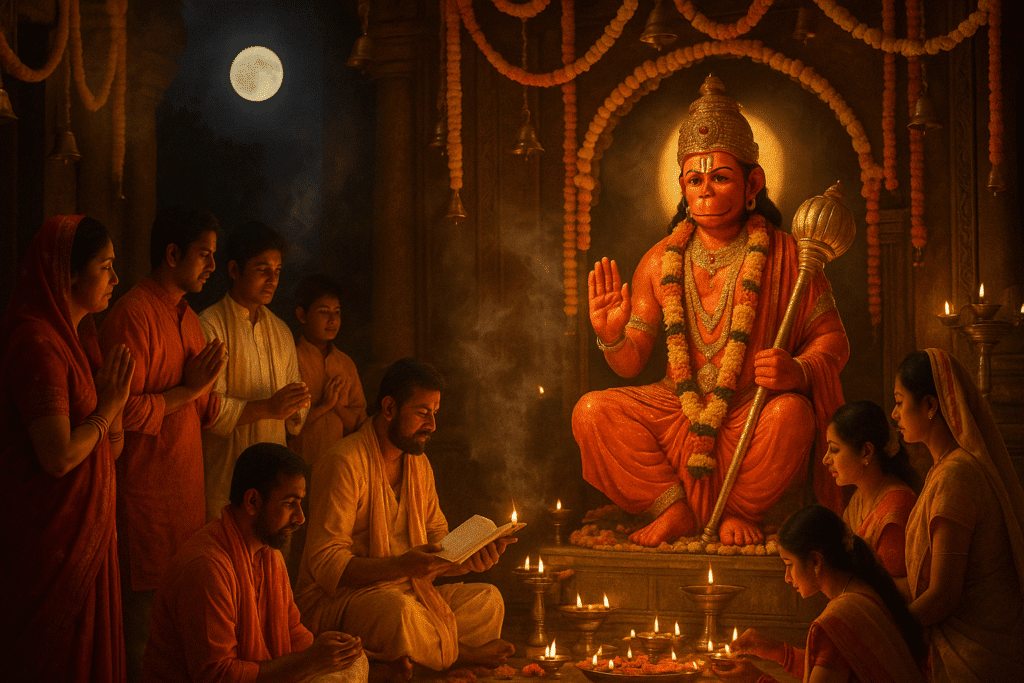Introduction
Hanuman Jayanti, a vibrant and spiritually significant Hindu festival, commemorates the birth of Lord Hanuman, the revered monkey god and ardent devotee of Lord Rama. Celebrated with fervor across India and by Hindu communities worldwide, this auspicious day is a time to honor Hanuman’s unparalleled strength, devotion, and selflessness. Observed typically on the full moon day (Purnima) of the Chaitra month (March-April) in the Hindu lunar calendar, Hanuman Jayanti inspires devotees to embody virtues like loyalty, courage, and humility. This article delves into the significance, traditions, and timeless teachings of Hanuman Jayanti, offering a fresh perspective on its enduring relevance.
The Mythological Significance of Hanuman
The Birth of a Divine Hero
According to Hindu scriptures, Hanuman was born to Anjana and Kesari, blessed by the wind god Vayu, who is considered his divine father. Known as Anjaneya or Maruti in his childhood, Hanuman’s birth was divinely ordained to serve Lord Rama, an incarnation of Lord Vishnu. Legends narrate how Hanuman, even as a child, displayed extraordinary strength and mischief, once leaping toward the sun, mistaking it for a fruit.
Hanuman in the Ramayana
Hanuman’s prominence stems from his role in the epic Ramayana, where he is depicted as Rama’s most trusted companion. From his unwavering loyalty to his miraculous feats—like leaping across the ocean to Lanka and carrying a mountain to save Lakshmana—Hanuman embodies the ideal of selfless service (seva). His devotion to Rama is so profound that he is often called “Ram Bhakt Hanuman,” symbolizing the perfect devotee.
The Spiritual Essence of Hanuman Jayanti
A Celebration of Devotion and Strength
Hanuman Jayanti is more than a festival; it is a spiritual journey that encourages devotees to cultivate inner strength and devotion. Hanuman is revered as the embodiment of bhakti (devotion), shakti (power), and gyana (wisdom). On this day, devotees reflect on his life and teachings, striving to emulate his discipline and surrender to the divine.
Symbolism of Hanuman’s Attributes
Hanuman’s mace, boundless energy, and ability to change forms symbolize the power to overcome obstacles. His humility, despite his immense capabilities, teaches the value of ego-less service. Hanuman Jayanti serves as a reminder that true strength lies in aligning one’s actions with righteousness and devotion.
Rituals and Traditions of Hanuman Jayanti
Temple Visits and Offerings
On Hanuman Jayanti, devotees throng temples dedicated to Hanuman, such as the famous Hanuman Garhi in Ayodhya or the Sankat Mochan temple in Varanasi. Temples are adorned with flowers, and the air resonates with chants of the Hanuman Chalisa, a 40-verse hymn composed by Tulsidas. Offerings like sindoor (vermilion), laddoos, and betel leaves are made, as sindoor is believed to be especially dear to Hanuman, symbolizing his devotion to Rama.
Fasting and Recitation
Many devotees observe a fast, either partial or complete, to seek Hanuman’s blessings for strength and protection. Reciting sacred texts like the Ramcharitmanas, Sunderkand, or Hanuman Ashtak is considered highly auspicious. The Hanuman Chalisa, in particular, is chanted 108 times in some households, believed to ward off evil and bring divine grace.
Community Celebrations
In regions like North India, grand processions, devotional music (bhajans), and enactments of Hanuman’s heroic deeds are organized. In South India, especially in Andhra Pradesh and Karnataka, the festival is marked by special pujas and the distribution of prasadam. These celebrations foster a sense of unity and shared reverence among devotees.
Hanuman Jayanti Across India
Regional Variations
While Hanuman Jayanti is celebrated nationwide, regional customs add unique flavors. In Maharashtra, it coincides with Marathi New Year (Gudi Padwa), blending festivities. In Tamil Nadu, some communities observe it during the Tamil month of Margazhi (December-January). In Andhra Pradesh, a 41-day vow (mandala) often culminates on Hanuman Jayanti, with devotees visiting temples to conclude their penance.
Modern-Day Celebrations
In contemporary times, Hanuman Jayanti has transcended traditional boundaries. Online streaming of Hanuman Chalisa recitations, virtual temple tours, and social media campaigns sharing Hanuman’s stories have made the festival accessible globally. Youth groups organize fitness events, inspired by Hanuman’s strength, such as wrestling or yoga sessions, blending spirituality with modern lifestyles.
Lessons from Hanuman for Modern Life
Embracing Selfless Service
Hanuman’s life teaches the power of selfless action. In a world driven by individualism, his example encourages serving others without expecting rewards, fostering compassion and community spirit.
Overcoming Challenges with Resilience
Known as Sankat Mochan (remover of obstacles), Hanuman inspires resilience. His ability to face daunting challenges—whether crossing oceans or battling demons—motivates individuals to confront personal and professional hurdles with courage.
Balancing Strength and Humility
Hanuman’s blend of immense power and humility is a timeless lesson. In an era of self-promotion, his humility reminds us to stay grounded, using our talents for the greater good.
Hanuman Jayanti and Environmental Consciousness
A lesser-explored aspect of Hanuman Jayanti is its potential to inspire environmental stewardship. Hanuman, as the son of Vayu (the wind god), is intrinsically linked to nature. His leaps through forests and reverence for the earth in the Ramayana can motivate devotees to protect the environment. Some modern Hanuman Jayanti celebrations include tree-planting drives and clean-up campaigns, aligning spirituality with sustainability.
Conclusion
Hanuman Jayanti is a celebration of devotion, strength, and the triumph of good over evil. It is a day to honor a divine figure whose life continues to inspire millions to live with purpose, courage, and humility. Whether through fasting, chanting, or reflecting on Hanuman’s timeless virtues, devotees find a path to inner transformation. As we navigate the complexities of modern life, Hanuman Jayanti offers a beacon of hope, reminding us that true power lies in faith, service, and resilience. Let us celebrate this sacred day by embracing Hanuman’s teachings, fostering a world rooted in compassion and unity.



